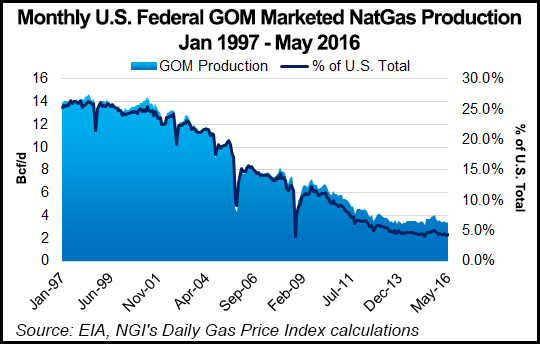GOM Storm Prompts Shut-In of More Than 11% of Offshore Oil, 5% of NatGas, BSEE Says
After more than two months of relative calm, the 2016 Atlantic hurricane season has become significantly more active, prompting operators in the Gulf of Mexico (GOM) to shut in more than 11% of oil and more than 5% of natural gas, but — for the moment, at least — the chances of any significant disruption seem to have lessened.

The National Hurricane Center (NHC) on Monday said it was tracking Tropical Depression Nine (TD9), which was pouring torrential rains over western Cuba and carried maximum sustained winds of 35 mph and was “likely to become a tropical storm” by midday Wednesday. TD9 was about 125 miles west-northwest of Havana and moving to the west at about 7 mph, but it was expected to turn toward the west-northwest during the day and toward the north Tuesday night, a track that would take it no farther west in the GOM than the Florida panhandle, with landfall in central Florida expected sometime Thursday.
Based on data from offshore operator reports submitted through 11:30 a.m. CDT Monday, personnel had been evacuated from six production platforms, less than 1% of the 781 manned platforms in the GOM, according to the Bureau of Safety and Environmental Enforcement (BSEE). Personnel had also been evacuated from one of the 16 rigs currently operating in the GOM, and five DP rigs have been moved off location out of the storm’s path, BSEE said.
“From operator reports, it is estimated that approximately 11.48% of the current oil production in the Gulf of Mexico has been shut in,” the agency said. “It is also estimated that approximately 5.51% of the natural gas production in the Gulf of Mexico has been shut in.”
Enbridge said it had evacuated nonessential personnel from the South Marsh Island 76, Ship Shoal 207 and Ship Shoal 332A platforms. However, weather had not impacted service on the Garden Banks, Manta Ray or Nautilus systems, and with TD9 forecast to head toward Florida, “there should be no impact on employees or operations,” an Enbridge spokesman told NGI Monday.
On Friday, BP plc was taking precautions as a tropical disturbance, the first of several to threaten the GOM beginning late last week, rolled out of the Atlantic Ocean near Cuba (see Daily GPI,Aug. 26a). “With forecasts indicating the system could enter the Gulf of Mexico, we are now taking additional steps to respond. BP had begun securing offshore facilities and evacuating nonessential personnel from our platforms and drilling rigs,” the London-based supermajor said Friday. Destin Pipeline, which is majority owned by BP, said Friday it had initiated Phase 2 of its Severe Weather Contingency Plan, which included the evacuation of all nonessential personnel from its onshore facilities.
Shell said late Friday that it was “taking the necessary steps to prepare and secure…assets in the Gulf of Mexico. This includes limiting the amount of personnel offshore to those directly involved in the core activities essential to maintaining safe operations. Drilling operations have been suspended and production is currently unaffected. Our priorities are the safety of personnel, protecting the environment and minimizing operational impact.”
Chevron said only that it was closely monitoring the system in the GOM on Monday.
NHC on Monday was also monitoring a weak trough of low pressure just offshore the central coast of Texas, which was drifting southwestward with little chance of becoming a tropical cyclone. On the other side of the Atlantic, a tropical wave was expected to move offshore of the west coast of Africa by early Tuesday, with a 50% chance of strengthening into a tropical cyclone within five days, NHC said.
NHC was also tracking TD8, which remained disorganized about 160 miles southeast of Cape Hatteras, NC. The depression was expected to become a tropical storm by early Tuesday as it approaches the North Carolina coast, before turning away to the northeast and farther into the Atlantic Wednesday.
Hurricane Gaston, packing maximum sustained winds of 110 mph and expected to remain a powerful hurricane for several days, was located about 560 miles east of Bermuda at 11 am AST, NHC said. Gaston was forecast to begin moving to the northeast by Monday night and shift to an east-northeastward motion Tuesday.
The first 12 weeks of the 2016 Atlantic hurricane season were mostly quiet, but the recent uptick in tropical storm activity has added some hurricane premium into the natural gas market (see Daily GPI, Aug. 26b).
Some forecasters still expect tropical activity this year that could threaten energy interests in the GOM and along the eastern seaboard (see Daily GPI, Aug. 11).
© 2024 Natural Gas Intelligence. All rights reserved.
ISSN © 1532-1231 | ISSN © 2577-9877 |
